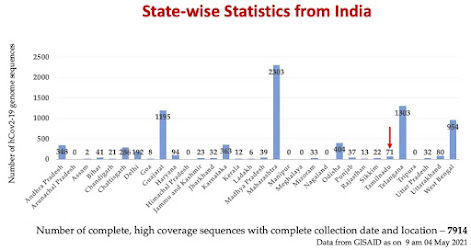Going forward, I think India should set up a robust genomic surveillance network to tackle any future endemic/epidemic/pandemic. A lot of thoughts and funds need to put into this in addition to investing in building up the overall public health infrastructure.
Tuesday, May 04, 2021
Genomic Surveillance - SARS-CoV-2 Virus
The advent of technology has enabled the possibility of using genome sequences to understand and combat the SARS-CoV-2 pandemic that started in 2019. Genome sequencing is particularly helpful in outbreak analysis and intervention, identifying variants and their pathological basis of spreading and infection, and a host of other possible understanding and paving way for interventions. It has been more than a year since the pandemic affected several countries now. They have been coping up and investing in infrastructure development and attending to immediate needs to help people. But simultaneously, countries have also set up genomic surveillance because that, along with epidemiological surveillance is important for treatment strategies and to curb the spread. India too has set up its genomic surveillance consortium, INSACOG (http://dbtindia.gov.in/insacog) - in the late 2020s, which is helping scientists study the spread and infection of the disease. However, as of now, the number of genome sequences in GISAID (https://www.gisaid.org) doesn't seem to commensurate with the number of reported cases, particularly in India, and more specifically in Tamilnadu. See the figures below (data collected from GISAID as of 9 am on 03 May 2021).
With the establishment of INSACOG and a good sampling strategy, I think the situation would improve in the coming days. I also hope that the government/research agencies will include more sequencing partners, improve clinic-academia partnership etc to improve genomic surveillance.
Subscribe to:
Post Comments (Atom)


No comments:
Post a Comment